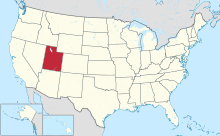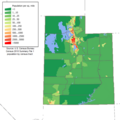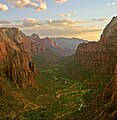Portal:Utah
The Utah Portal  Utah (/ˈjuːtɑː/ YOO-tah, /ˈjuːtɔː/ YOO-taw) is a landlocked state in the Mountain West subregion of the Western United States. It is one of the Four Corners states, sharing a border with Arizona, Colorado, and New Mexico. It also borders Wyoming to its northeast, Idaho to its north, and Nevada to its west. In comparison to all the U.S. states and territories, Utah, with a population of just over three million, is the 13th largest by area, the 30th most populous, and the 11th least densely populated. Urban development is mostly concentrated in two regions: the Wasatch Front in the north-central part of the state, which includes the state capital, Salt Lake City, and is home to roughly two-thirds of the population; and Washington County in the southwest, which has somewhat more than 180,000 residents. Most of the western half of Utah lies in the Great Basin. Utah has been inhabited for thousands of years by various indigenous groups, such as the ancient Puebloans, the Navajo, and the Ute. The first Europeans to arrive - in the mid-16th century - were the Spanish. Because of the region's challenging geography and harsh climate, it only became a peripheral part of New Spain (and later of Mexico). Even while it was Mexican territory, many of the Utah region’s earliest European settlers were from the United States; notable among these were Mormons who were fleeing marginalization and persecution in the United States and arrived via the so-called Mormon Trail. In 1848, after the Mexican–American War, the region was annexed by the U.S., becoming part of the Utah Territory, which included what later became Colorado and Nevada. Disputes between the dominant Mormon community and the federal government delayed Utah's admission as a state: in 1896, after it agreed to outlaw polygamy, it was admitted as the 45th state. People from Utah are known as Utahns. Slightly over half of all Utahns are Mormons, the vast majority of whom are members of the Church of Jesus Christ of Latter-day Saints (LDS Church), which has its world headquarters in Salt Lake City; Utah is the only state where a majority of the population belongs to a single church. The LDS Church greatly influences Utahn culture, politics, and daily life, though since the 1990s the state has become more religiously diverse as well as secular. (Full article...) Entries here consist of Good and Featured articles, which meet a core set of high editorial standards.
Fawn McKay Brodie (September 15, 1915 – January 10, 1981) was an American biographer and one of the first female professors of history at UCLA, who is best known for Thomas Jefferson: An Intimate History (1974), a work of psychobiography, and No Man Knows My History (1945), an early biography of Joseph Smith, the founder of the Latter Day Saint movement. Raised in Utah in a respected, if impoverished, family who were members of the Church of Jesus Christ of Latter-day Saints (LDS Church), Fawn McKay drifted away from Mormonism during her years of graduate work at the University of Chicago and married Bernard Brodie, an academic who became a national defense expert; they had three children. Although Fawn Brodie eventually became one of the first tenured female professors of history at UCLA, she is best known for her five biographies, four of which incorporate insights from Freudian psychology. (Full article...) Selected image -November selected anniversaries
Selected biography -Selected article -Same-sex marriage has been legal in Utah since October 6, 2014. On December 20, 2013, the state began issuing marriage licenses to same-sex couples as a result of the U.S. District Court for the District of Utah's ruling in the case of Kitchen v. Herbert, which found that barring same-sex couples from marrying violates the U.S. Constitution. The issuance of those licenses was halted during the period of January 6, 2014 until October 6, 2014, following the resolution of a lawsuit challenging the state's ban on same-sex marriage. On that day, following the U.S. Supreme Court's refusal to hear an appeal in a case that found Utah's ban on same-sex marriage unconstitutional, the Tenth Circuit Court of Appeals ordered the state to recognize same-sex marriage. Same-sex marriage became temporarily legal in Utah on December 20, 2013, as a result of a ruling from the U.S. District Court for the District of Utah. The U.S. Supreme Court stayed the ruling on January 6, 2014, while the Tenth Circuit Court of Appeals in Denver considered the case. On June 25, 2014, the Tenth Circuit upheld the lower court ruling, a decision that set a precedent for every state within the circuit. However, the Tenth Circuit stayed its ruling. On October 6, the Supreme Court refused to hear the state's appeal, requiring Utah to license and recognize same-sex marriages. Same-sex marriages that were performed in December 2013 and January 2014 are recognized by the federal government, but a ruling requiring the state of Utah to recognize such marriages was stayed by the U.S. Supreme Court on July 18, 2014. The state later asked the Tenth Circuit to dismiss its appeal in this case. (Full article...) Did you know -
Selected panorama - Tower of Babel in Arches National Park
TopicsCategoriesGeneral imagesThe following are images from various Utah-related articles on Wikipedia.
State facts
State symbols:
Featured contentArticles:
Lists:
Pictures: Related portals
Lists
Related WikiProjectsNew articlesThis list was generated from these rules. Questions and feedback are always welcome! The search is being run daily with the most recent ~14 days of results. Note: Some articles may not be relevant to this project.
Rules | Match log | Results page (for watching) | Last updated: 2024-11-18 22:12 (UTC) Note: The list display can now be customized by each user. See List display personalization for details.
Things you can doAssociated WikimediaThe following Wikimedia Foundation sister projects provide more on this subject:
Discover Wikipedia using portals |

















































































